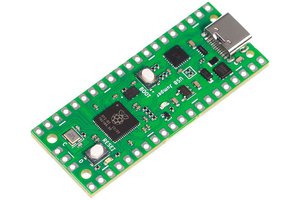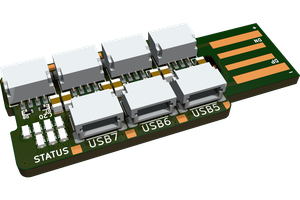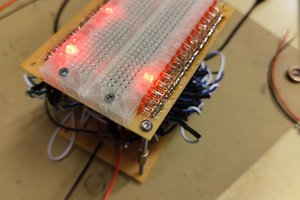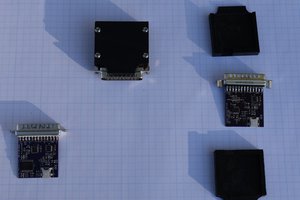This project has been on the drawing board for a couple of years now. It gets pushed back up to the top of the list towards the end of each calendar year, with the Cub Scout pinewood derby each January serving as the reminder. Next year will be my last year with the Cub Scouts (my youngest son moves on to Boy Scouts next year) so 2016 will be my "swan song" in terms of the pinewood derby. So, it's now or never! (well, not really, but I'll use that as motivation)
I opted to use a few "off the shelf" items rather than a complete "from scratch" design. I have a bunch of DLP designs' DLP2232 USB to UART bridge modules laying around, so I used one of those. I purchased several LM2596HV DC-DC modules a while ago, so rather than rolling my own (or copying that one) I just place the whole PCB module onto the board. Sheer laziness on my part.
The PC-side box is the easiest to describe, so I'll start there first. This is really just a USB-to-RS422 converter. I had several MAX485 RS485 transceivers laying around, so I use two of those, each one permanently fixed as either an RS422 transmitter or a receiver. The MAX485 devices are powered from the USB 5V supply. I use CAT5 pairs 1-2 and 3-6 for the RS422 transmit and receive pair, respectively. I use CAT5 pairs 4-5 and 7-8 for +48V and ground, respectively. This is (intended) to be compatible with how PoE uses a CAT5 cable for power distribution. Of course, I have to have LED's! So, an LED for the USB RX and USB TX activity, as well as an LED for USB 5V, and an LED for 48V. For the 48V indicator LED I decided to implement a voltage detector circuit, that will illuminate the LED only if the applied voltage is above 40V. The intent here is that I don't want this LED to illuminate (even dimly) if a lower voltage is applied - that would lead to more current through the CAT5, which we want to avoid. The idea is, if the 48V LED is on, then everything is OK from the supply side.
The Track-side box is a bit more complicated, but still pretty simple. This is just a RS422 to RS232 converter. Again, I use a pair of MAX485 transceivers for RS422 to logic conversion. I use a MAX232 (OMG I still have tons of these) to convert the logic to RS232 levels, which is what the derby finish line wants. On the track-side, the power situation is quite different. The incoming 48V is bucked down to 9V using a DC-DC converter module from eBay. These modules are cheaper (shipped) than what I would pay to buy the components! A 78L05 linear vreg supplies 5V to the MAX485 and MAX232 devices, and is powered from the 9V output of the DC-DC converter. There are LED's on this side too, naturally. RS232 TX and RX and 5V and 9V indicators. A voltage detector circuit, similar to that on the PC side, only illuminates a 9V indicator LED if the 9V rail is above 8.5 volts or so.
The derby finish line consumes 9V at 600mA, or 5.4W. My measurements while it's operating are quite a bit lower (more like 450mA or so) but I'll use 600mA as a maximum. The DC-DC converter is probably about 85% efficient (ballpark) in this configuration so that's 6.3W required at its input. The result is that about 130mA of current flows through the CAT5 feed, which should be fine - that's well below what PoE applications push through a CAT5 cable.
 tomcircuit
tomcircuit
 CentyLab
CentyLab
 rbtsco
rbtsco

 Bharbour
Bharbour